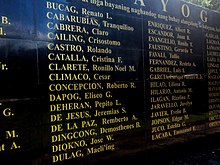Gerry Faustino
Gerry Faustino | |
|---|---|
 Detail of the Wall of Remembrance at the Bantayog ng mga Bayani, showing names from the first batch of Bantayog Honorees, including that of Gerry Faustino | |
| Born | Gerardo T. Faustino September 24, 1955 |
| Disappeared | July 31, 1977 (aged 21) Makati |
| Status | Missing for 47 years, 4 months and 3 days |
| Alma mater | University of the Philippines Los Baños |
| Occupation | Activist |
| Awards | Honored at the Bantayog ng mga Bayani wall of remembrance |
Gerardo T. Faustino (September 24, 1955 – disappeared July 31, 1977) was a Filipino student leader and activist from the University of the Philippines Los Baños[1][2] who is best known as one of the most prominent desaparecidos of the Marcos Martial Law era in the Philippines.[3]
Faustino is one of heroes honored by the University of the Philippines Los Baños in its 'Hagdan ng Malayang Kamalayan' memorial,[4] and his name is inscribed on the Wall of Remembrance at the Bantayog ng mga Bayani, a memorial that honors martyrs and heroes who fought the dictatorship.[5][6]
Student life at the University of the Philippines Los Baños
[edit]Gerry Faustino first enrolled as a freshman at the University of the Philippines in Los Baños (UPLB) in 1973, taking up a Bachelor of Science degree in Agriculture[6] only a year after the University of the Philippines College of Agriculture was elevated as the newly created UP System's first autonomous campus. It was also the year after Ferdinand Marcos' declaration of Martial Law in September 1972.[7]
He soon joined the UP Student Catholic Action (UP SCA), one of the few student organizations still recognized by the university after most such organizations were banned after Martial Law. Already known for being politically aware, he demonstrated leadership potential by participating in the UPSCA's extension programs. He was eventually elected as a representative to the UPLB student conference, a body that had been formed by the UPLB studentry to push for the restoration of the UPLB Student Council, which had been abolished after the proclamation of martial law.[6]
Disappearance
[edit]Gerry Faustino was 21 years old on July 31, 1977, when he was kidnapped with nine other UPLB activists in Makati. The group eventually became known as the “Southern Tagalog 10,” whose disappearance is considered the most prominent case of abduction under martial law.[7]
Only the body of Modesto Sison, one of the ten activists, was found, although the Philippine military later claimed that three of woman activists—Rizalina Ilagan, Cristina Catalla and Jessica Sales—had been killed in an encounter in Mauban, Quezon.[6] No clues about the whereabouts of the other six activists have ever been found.[7]
See also
[edit]References
[edit]- ^ "Hagdan ng Malayang Kamalayan serves as venue for tribute night". University of the Philippines Los Baños College of Arts and Sciences. Archived from the original on 2019-02-14. Retrieved 2019-02-14.
- ^ Baraoidan, Kimmy; Cinco, Maricar (2017-03-15). "Marker reminds youth to be vigilant amid threats of strongman rule". The Philippine Daily Inquirer. Retrieved 2019-02-14.
- ^ "The story of the Southern Tagalog 10". Bantayog ng mga Bayani. 2017-10-11. Retrieved 2019-02-14.
- ^ Laksamana, Mariz (2017-03-11). "'Hagdan ng Malayang Kamalayan', pinasinayanan sa UPLB". ABS-CBN News and Public Affairs. Retrieved 2018-11-28.
- ^ Malay, Carolina S. (2015). Ang Mamatay nang Dahil sa 'Yo: Heroes and Martys of the Filipino People in the Struggle Against Dictatorship 1972-1986 (Volume 1). Rodriguez, Ma. Cristina V. Manila, Philippines: National Historical Commission of the Philippines. ISBN 9789715382700. OCLC 927728036.
- ^ a b c d "Martyrs & Heroes: FAUSTINO, Gerardo T." Bantayog ng mga Bayani. 2015-10-15. Retrieved 2019-02-14.
- ^ a b c Enano, Jhesset O. (2017-09-20). "Martial law victims find no justice in 'moving on'". The Philippine Daily Inquirer. Retrieved 2019-02-14.
- 1955 births
- 1970s missing person cases
- Enforced disappearances in the Philippines
- History of the Philippines (1965–1986)
- Individuals honored at the Bantayog ng mga Bayani
- Marcos martial law victims
- Martial law under Ferdinand Marcos
- Missing people
- Missing person cases in the Philippines
- Political repression in the Philippines
- Presidency of Ferdinand Marcos
- Southern Tagalog 10
- University of the Philippines Los Baños
- University of the Philippines Los Baños people honored at the Bantayog ng mga Bayani
- Filipino people stubs
